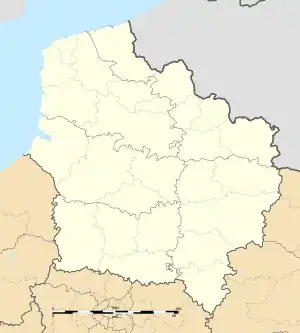Caours | |
|---|---|
.JPG.webp) The town hall in Caours | |
Location of Caours | |
 Caours  Caours | |
| Coordinates: 50°07′53″N 1°52′59″E / 50.1314°N 1.8831°E | |
| Country | France |
| Region | Hauts-de-France |
| Department | Somme |
| Arrondissement | Abbeville |
| Canton | Abbeville-1 |
| Intercommunality | CA Baie de Somme |
| Government | |
| • Mayor (2020–2026) | Bernard Duquesne[1] |
| Area 1 | 6.13 km2 (2.37 sq mi) |
| Population | 581 |
| • Density | 95/km2 (250/sq mi) |
| Time zone | UTC+01:00 (CET) |
| • Summer (DST) | UTC+02:00 (CEST) |
| INSEE/Postal code | 80171 /80132 |
| Elevation | 6–87 m (20–285 ft) (avg. 15 m or 49 ft) |
| 1 French Land Register data, which excludes lakes, ponds, glaciers > 1 km2 (0.386 sq mi or 247 acres) and river estuaries. | |
Caours (French pronunciation: [ka.uʁ]; Picard: Cœu) is a commune in the Somme department in Hauts-de-France in northern France.
Geography
Caours is situated some 3 miles (5 km) northeast of Abbeville, on the D482 road heading towards Saint-Riquier.
Population
| Year | Pop. | ±% p.a. |
|---|---|---|
| 1968 | 388 | — |
| 1975 | 508 | +3.92% |
| 1982 | 567 | +1.58% |
| 1990 | 599 | +0.69% |
| 1999 | 592 | −0.13% |
| 2007 | 598 | +0.13% |
| 2012 | 610 | +0.40% |
| 2017 | 603 | −0.23% |
| Source: INSEE[3] | ||
History
Stone-age archaeology
The fluvial deposits of the Somme around Caours have been well known to archaeologists in the latter part of the 20th century, are remains of a time when climate was more temperate. The last interglacial, once known under the name of Riss-Würm, was between 130,000 and 115,000 years ago. The area has produced the remains of mammals of this Paleolithic era, notably antlers and bone. A joint research programme by the INRAP and the CNRS in 2005, has produced interesting results about Neandertal man. [4][5]
The theory that once explained the disappearance of the Neandertals, the inability to adapt to climatic
change has suddenly been put into perspective by the site of Caours.[6]
See also
References
- ↑ "Répertoire national des élus: les maires". data.gouv.fr, Plateforme ouverte des données publiques françaises (in French). 2 December 2020.
- ↑ "Populations légales 2021". The National Institute of Statistics and Economic Studies. 28 December 2023.
- ↑ Population en historique depuis 1968, INSEE
- ↑ Article sur le site de l'INRAP : Néandertal s'invite à l'Eémien Archived December 1, 2006, at the Wayback Machine (page consultée le 5 mars 2007)
- ↑ Communiqué de presse de l'INRAP : Néandertal s'invite à l'Eémien Archived December 1, 2006, at the Wayback Machine (page consultée le 5 mars 2007)
- ↑ Jean-Philippe Noël, « Neandertal. Le mystère de sa disparition s'épaissit », dans Science et Vie, no. 1074, mars 2007, pp. 86-88.